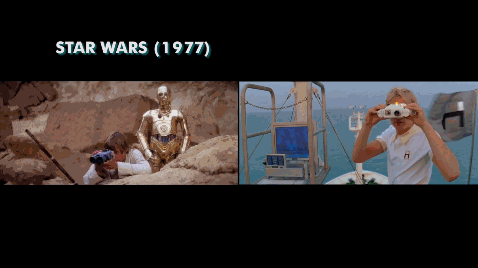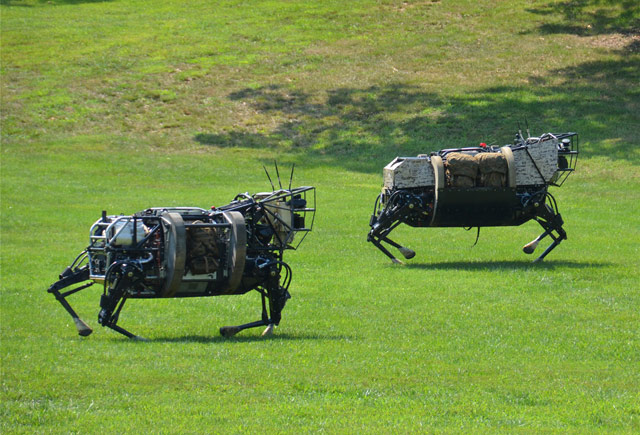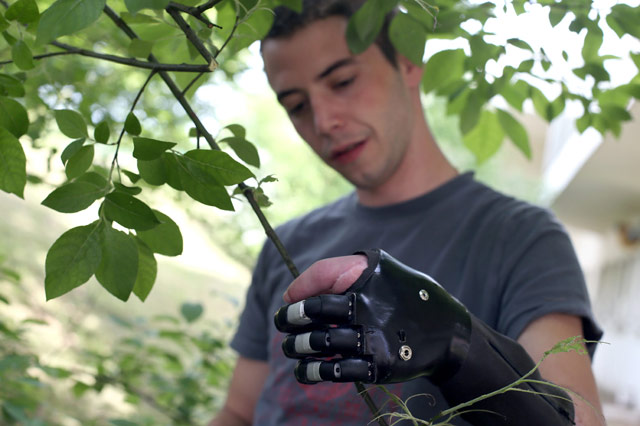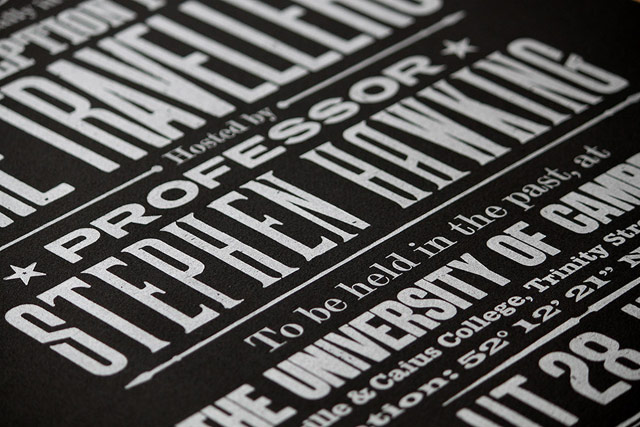Entries for October 2013
Not to get all Malcolm Gladwell here, but it’s counterintuitive that hot water freezes faster than cold water. The phenomenon is called the Mpemba effect and until recently, no one could explain how it works. A group of researchers in Singapore think they’ve cracked the puzzle.
Now Xi and co say hydrogen bonds also explain the Mpemba effect. Their key idea is that hydrogen bonds bring water molecules into close contact and when this happens the natural repulsion between the molecules causes the covalent O-H bonds to stretch and store energy.
But as the liquid warms up, it forces the hydrogen bonds to stretch and the water molecules sit further apart. This allows the covalent molecules to shrink again and give up their energy. The important point is that this process in which the covalent bonds give up energy is equivalent to cooling.
In fact, the effect is additional to the conventional process of cooling. So warm water ought to cool faster than cold water, they say. And that’s exactly what is observed in the Mpemba effect.
(via ★djacobs)
Real Kitchen, a small Chicago eatery that mostly does take-out food, dressed up as Michelin 3-star Alinea for Halloween. Some genuine LOLs here, especially the table-side dessert to-go.
For his latest What If? column, Randall Munroe tackles the question “When, if ever, will Facebook contain more profiles of dead people than of living ones?”
Based on the site’s growth rate, and the age breakdown of their users over time, there are probably 10 to 20 million people who created Facebook profiles who have since died.
That’s an incredible number; most tech startups would kill (well, not really but maybe…) for that many alive users.
This month, Smithsonian magazine tells the story of America using 101 objects drawn from the 19 musuems and research centers of the Smithsonian Institution. Among the objects are the original Star Spangled Banner flag, the passenger pigeon, the polio vaccine, the pill, and Benjamin Franklin’s Experiments and Observations on Electricity.

A companion book, The Smithsonian’s History of America in 101 Objects, is available.
Adrian Cárdenas, formerly a player for the Chicago Cubs, quit baseball to pursue an education in creative writing and philosophy.
I wish I had looked up more often, even at the cost some of my success. The American dream didn’t tell me that an experience only matters if I acknowledge it, that losing yourself in the game is a good way to lose what makes life meaningful. When you’re standing at the plate and you hit a sharp foul ball to the backstop, the spot on the bat that made contact gets hot; the American dream forgot to tell me to step back and enjoy the smell of burnt wood.
In Focus has a selection of winning photos from Nikon’s Small World Photomicrography Competition. The award for most terrifying goes to Dimitri Seeboruth for his shot of a worker ant:

I, for one, welcome our new insect overlords.
Greg Packer gets quoted in the news a lot, an area man among mere area boys. Andrew David Watson added fuel to his fire by producing a short film about Packer for the New Yorker.
Filed under even if it’s fake it’s real. (via ★interesting)
Jay Zeamer and a group of fellow misfits collectively called the Eager Beavers were an American photoreconnaissance team in the Pacific theater during WWII. They flew their beat-up B-17 bomber into enemy territory to collection reconnaissance photographs. Roger Cicala shares the engaging story of their most noteworthy photo.
The only crew that volunteered, of course, was Jay Zeamer and the Eager Beavers. One of the crew, bombardier Joseph Sarnovski, had absolutely no reason to volunteer. He’d already been in combat for 18 months and was scheduled to go home in 3 days. Being a photo mission, there was no need for a bombardier. But if his friends were going, he wanted to go, and one of the bombardier’s battle stations was to man the forward machine guns. They might need him, so he went.
They suspected the airstrip at Buka had been expanded and reinforced, but weren’t sure until they got close. As soon as the airfield came in sight, they saw numerous fighters taking off and heading their way. The logical thing to do would have been to turn right and head for home. They would be able to tell the intelligence officers about the increased number of planes at Buka even if they didn’t get photos.
But Zeamer and photographer William Kendrick knew that photos would be invaluable for subsequent planes attacking the base, and for Marines who were planning to invade the island later. Zeamer held the plane level (tilting the wings even one degree at that altitude could put the photograph half a mile off target) and Kendrick took his photos, which gave plenty of time for over 20 enemy fighters to get up to the altitude Old 666 was flying at.
(via petapixel)
In this 7-minute interview, Alfred Hitchcock explains his editing/cutting technique.
The full interview from which this is taken, which is “part interview, part master class in the craft of telling stories on film”, is available on YouTube: part 1 and part 2.
This summer, Lou Reed reviewed Kanye West’s Yeezus, praising the albums contradictions.
Very often, he’ll have this very monotonous section going and then, suddenly — “BAP! BAP! BAP! BAP!” — he disrupts the whole thing and we’re on to something new that’s absolutely incredible. That’s architecture, that’s structure — this guy is seriously smart. He keeps unbalancing you. He’ll pile on all this sound and then suddenly pull it away, all the way to complete silence, and then there’s a scream or a beautiful melody, right there in your face. That’s what I call a sucker punch.
He seems to have insinuated in a recent New York Times interview that My Beautiful Dark, Twisted Fantasy was to make up for stupid shit he’d done. And now, with this album, it’s “Now that you like me, I’m going to make you unlike me.” It’s a dare. It’s braggadoccio. Axl Rose has done that too, lots of people have. “I Am a God” — I mean, with a song title like that, he’s just begging people to attack him.
(via @dunstan)
Speaking of Wes Anderson, Matt Zoller Seitz has finished his video essay series on Anderson’s movies. You can find the entire collection of videos on Vimeo and transcripts and notes are on Seitz’s blog. Here are the final two to get you going:
And if that’s not enough for you, here’s the book that the videos are based on.
A blooper reel from the original Star Wars…looks like this hasn’t ever been seen before.

Right now, two men on skis pulling 440 lb sleds are inching their way across the Antartic continent, bound for the South Pole and then back again. Ben Saunders and Tarka L’Herpiniere are attempting to complete, solo and unsupported, the same journey that claimed the lives of Robert Falcon Scott and his party in 1912. They’re calling it The Scott Expedition.
Saunders has been working towards this goal for more than 10 years with many false starts. His former partner in exploration, Tony Haile, explains the journey before the journey:
In short, a South Pole expedition is pretty much the worst way to spend four months you could possibly imagine, but if you were to ask Ben I don’t think he would say that’s the tough part. The tough part is getting to the start line in the first place. Antarctica is far away from everywhere and doing anything in Antarctica is ridiculously expensive. Imagine if you kept a car in New York but the only way to fuel that car was to charter a private jet and fly fuel in from England. That’s the logistics of an Antarctic expedition and between us we had no cash and no clue how to get any.
We didn’t go to the South Pole in 2003. Or 2004. Or 2005. Living month to month on whatever I could scrounge together, putting together small expeditions or managing other people’s just so I wouldn’t lose my connection to the cold places, I grew to fear and then hate my parent’s yearly Christmas letter to their friends which would explain ‘Anthony has decided to postpone his South Pole expedition for another year to raise more funds’. For Ben and I, we had proclaimed a grand goal. We had told people year after year this was the year we were finally going to go south. And every year we had to look at the nervous smiles as we publicly failed. Again and again.
The journey is just underway…the plan is to travel 1800 miles to and from the South Pole and you can track their progress online and read tweets and blog posts from Ben and Tarka along the way. Back in 2005, when Ben and Tony were planning this trip the first time around, they sold miles of the expedition for donations of $100 apiece. They didn’t make it that year obviously and in the days before Kickstarter, crowdsourcing $180,000 was a bit more difficult than it is now. But I bought a mile back then (I actually got mile #900, the point at which they’ll reach the pole) and I am beyond excited that they’ve set off and can’t wait to see how the trip progresses. Good luck, Ben and Tarka!
The Atlantic asked a group of historians, scientists, and engineers to rank the 50 greatest innovations since the invention of the wheel. Here they are.
21. Nuclear fission, 1939
Gave humans new power for destruction, and creation
22. The green revolution, mid-20th century
Combining technologies like synthetic fertilizers (No. 11) and scientific plant breeding (No. 38) hugely increased the world’s food output. Norman Borlaug, the agricultural economist who devised this approach, has been credited with saving more than 1 billion people from starvation.
23. The sextant, 1757
It made maps out of stars.
This video dicusses three simple ways to travel through time (all of which you can do right now at home) and three not-so-simple time travel methods.
For more on time-travel, here are some works by physicist and time-lord Sean Carroll:
Rules for time-travellers - http://blogs.discovermagazine.com/cos…
Learn more about time and time-machines in his book From Eternity to Here - http://preposterousuniverse.com/etern…
Visualizations of the spinning universe - http://iopscience.iop.org/1367-2630/1…
An engaging talk on the Paradoxes of Time Travel - https://vimeo.com/11917849
(via digg)
Wes Anderson is coming out with a new horror movie. Here’s the trailer:
Ha ha just kidding it’s a SNL spoof. Ed Norton does a pretty ripping Owen Wilson.
A fascinating thread on Reddit asks why & how ex-neo-Nazis, skinheads, and racists changed their minds regarding racism.
I was sitting on the bus on my way home one day. I was listening to some good music in my headphones. It was a cloudless autumn day and everything was a healthy yellow and orange color and blue sky. At a stop a african man and a young boy, maybe 5-6 years, got on. The man was tall and had bad clothes, he looked like he did not have much. They sat in front of me. I immediately became annoyed and started to think about how I hated them, fucking immigrants coming to my country, he is poor and I pay taxes so he can get welfare. I thought about how his son is going to become a lousy shit and rape white women. I started to get mad and decided to beat him up, I was going to follow him when he got off the bus.
I saw him press the button and got ready at the next stop, and just before we stopped I was about to get up and the man turned to his son and said something in a heavy accent that I will never forget in my life.
“I love you my son, be good.”
He then gave him a big, hard hug and the boy got off the bus alone. He waved good bye and sat back down, with his hands on his face. I just stared out the window where his son had been standing. My world view came crashing. He was just a father who wanted his son to be good, he loved him just like my father loved me. For some reason this changed everything for me. I know this is a very small thing but I started to think about how he wanted a better life for his son. He was a man that had changed everything for his family.
I sat on that bus for hours, it kept going around. I thought about how wrong it was to do the things I had done. I left that city the next day and started over. I am much happier now. I dont feel the hate in my heart every day anymore.
Curious use of the word “Africans” in several of the comments…is that a socially acceptable term in Europe or a vestige of the commenters’ racist pasts? Or are they simply referring to recent immigrants from Africa? (via digg)
Mary HK Choi spent the first dozen years of her life at odds with her mother but now she loves her so much it kills her. A lovely offbeat story of mothers and daughters.
I love my mother a not-normal amount. It’s all twisty because she tried to kill me when I was young. Just kidding. My mom is an excellent mom. She knows I am irascible, prickly and antisocial. She knows that most human interaction makes me tired and that I either scare people away with precise invectives or trot out the fakest, nicest skinjob of myself because it requires zero effort. She nails me on all of it, asking one billion follow-up questions until I get behind my eyeballs and engage. She forces me to call distant relatives, dialling the phone and pressing it into my cheek while my eyes get hot and watery. She pulls rank all the time and once judo-flipped me onto my back in a grocery store to remind me where things stood. She is my favorite and it makes me crazy. You can tell that she was popular in school, but I am a fundamentally more popular person. I care more and I’m great at rules. I’ve known it since the first grade.
The top comment on the story is well worth a read as well:
Justin went berserk.
I’d NEVER heard a kid scream so loud or for so long and still manage to run around a room tearing drawings off the wall, shoving kids all over the place, tossing chairs across the room.
It was AWESOME, in a moderately terrifying kind of way.
And the tears. Oh the tears. You’d have thought we’d taken his pet dog and made him slit its throat and then skin and cook it.
That day NEVER ended. I mean of course it did, but it never ended. You know what I mean. So, I’m hanging in the room straightening up from Justin’s rampage, when our supervisor comes in and tells me to come outside.
Which is how I met Justin’s grandparents, the two nicest, sweetest grandparents ever. No, nicer and sweeter then that. When I stuck my hand out they brushed that aside and it was semi-bear hug time. They both thanked me for what I was doing with Justin and how he didn’t talk about anything else but me.
Hmm, this looks interesting: an upcoming book on the science of booze written by Adam Rogers.
In Proof, Adam Rogers reveals alcohol as a miracle of science, going deep into the pleasures of making and drinking booze-and the effects of the latter. The people who make and sell alcohol may talk about history and tradition, but alcohol production is really powered by physics, molecular biology, organic chemistry, and a bit of metallurgy-and our taste for those products is a melding of psychology and neurobiology.
Proof takes readers from the whisky-making mecca of the Scottish Highlands to the oenology labs at UC Davis, from Kentucky bourbon country to the most sophisticated gene-sequencing labs in the world — and to more than one bar — bringing to life the motley characters and evolving science behind the latest developments in boozy technology.
Rogers wrote the piece about the mystery whiskey fungus I linked to a couple of years ago.
NASA’s Solar Dynamics Observatory is getting some really amazing shots of the Sun, including this 200,000 mile-long solar eruption that left a huge canyon on the surface of the Sun:
Different wavelengths help capture different aspect of events in the corona. The red images shown in the movie help highlight plasma at temperatures of 90,000° F and are good for observing filaments as they form and erupt. The yellow images, showing temperatures at 1,000,000° F, are useful for observing material coursing along the sun’s magnetic field lines, seen in the movie as an arcade of loops across the area of the eruption. The browner images at the beginning of the movie show material at temperatures of 1,800,000° F, and it is here where the canyon of fire imagery is most obvious.
The level of detail shown is incredible. (via @DavidGrann)
In an interview accompanying a Frontline episode on drug-resistant bacteria, an associate director for the CDC, Dr. Arjun Srinivasan, says that “we’re in the post-antibiotic era”.
The more you use an antibiotic, the more you expose a bacteria to an antibiotic, the greater the likelihood that resistance to that antibiotic is going to develop. So the more antibiotics we put into people, we put into the environment, we put into livestock, the more opportunities we create for these bacteria to become resistant. …We also know that we’ve greatly overused antibiotics and in overusing these antibiotics, we have set ourselves up for the scenario that we find ourselves in now, where we’re running out of antibiotics.
We are quickly running out of therapies to treat some of these infections that previously had been eminently treatable. There are bacteria that we encounter, particularly in health-care settings, that are resistant to nearly all — or, in some cases, all — the antibiotics that we have available to us, and we are thus entering an era that people have talked about for a long time.
For a long time, there have been newspaper stories and covers of magazines that talked about “The end of antibiotics, question mark?” Well, now I would say you can change the title to “The end of antibiotics, period.”
We’re here. We’re in the post-antibiotic era. There are patients for whom we have no therapy, and we are literally in a position of having a patient in a bed who has an infection, something that five years ago even we could have treated, but now we can’t.
You know how when you first hear a joke it’s the funniest thing ever and then you hear it a second time and it’s less funny and then a third, fourth, and fifth times and it just keeps getting less and less funny until you’re not laughing at all and it actually becomes annoying? That’s how antibiotics work across the entire human population. And if Dr. Srinivasan is correct, we’re transitioning into the not laughing stage and the annoying stage where lots of people start dying can’t be far behind (unless we get some new jokes/treatments).
Yesterday, Mark Sample tweeted about disasters, low-points, and chronic trauma:
“Low point” is the term for when the worst part of a disaster has come to pass. Our disasters increasingly have no low point.
After the low point of a disaster is reached, things begin to get better. When there is no clear low point, society endures chronic trauma.
Disasters with no clear low point: global warming, mass extinction, colony collapse disorder, ocean acidification, Fukushima.
To which I would add: drug-resistant infectious diseases. (via digg)
This video of Atlanta cheerleader Mikayla Clark breaking the world backflip record is mesmerizing. I did not know there was a world backflip record, but here is someone breaking it last year, too.
Yes, it is gymnastics day on kottke.org, what of it?
Usually open letters to big companies take the form of scolding. Chris Horst wrote the CEO of Costco a different sort of open letter.
For his entire life, Matthew has been classified and known by his “special needs”. Since the day he began at Costco, however, his coworkers and customers have valued him because of his unique strengths. There are many companies which “succeed” at the expense of their workers. I am a firsthand witness to a counterintuitive company: Costco succeeds through the flourishing of its employees.
Matthew worked for years in the Costco parking lot (bearing the wind, rain, cold and snow), taking pride when it was free of carts. And, true to the rumors (that Costco promotes from within), he eventually was given the opportunity to work in the warehouse as a cashier’s assistant, supporting customers as they check-out. He absolutely loves his job…and his customers absolutely love him.
Costco is a famously decent employer, as far as massive corporations go. Their workers, though mostly not unionized, are paid more and get better health care than their competitors. They promote from within. The CEO only makes 12 times more than a typical employee (Wal-Mart’s CEO’s salary was 58 times a typical employee’s salary). (via @khoi)
Russell Brand, the actor and comedian, guest edited the latest issue of the New Stateman. In a piece from that issue, Brand details his political philosophy and asks if a utopian revolution is possible.
Perhaps this is why there is currently no genuinely popular left-wing movement to counter Ukip, the EDL and the Tea Party; for an ideology that is defined by inclusiveness, socialism has become in practice quite exclusive. Plus a bit too serious, too much up its own fundament and not enough fun. The same could be said of the growing New Age spiritual movement, which could be a natural accompaniment to social progression. I’m a bit of a tree-hugging, Hindu-tattooed, veggie meditator myself but first and foremost I want to have a fucking laugh. When Ali G, who had joined protesters attempting to prevent a forest being felled to make way for a road, shouted across the barricade, “You may take our trees, but you’ll never take our freedom,” I identified more with Baron Cohen’s amoral trickster than the stern activist who aggressively admonished him: “This is serious, you cunt.”
A bit too fucking serious, actually. As John Cleese said, there is a tendency to confuse seriousness with solemnity. Serious causes can and must be approached with good humour, otherwise they’re boring and can’t compete with the Premier League and Grand Theft Auto. Social movements needn’t lack razzmatazz.
The right has all the advantages, just as the devil has all the best tunes. Conservatism appeals to our selfishness and fear, our desire and self-interest; they neatly nurture and then harvest the inherent and incubating individualism.
I imagine that neurologically the pathway travelled by a fearful or selfish impulse is more expedient and well travelled than the route of the altruistic pang. In simple terms of circuitry I suspect it is easier to connect these selfish inclinations.
This piece is filled with interesting and entertaining bits throughout, making it difficult to pick just one excerpt. Here’s another then:
We are still led by blithering chimps, in razor-sharp suits, with razor-sharp lines, pimped and crimped by spin doctors and speech-writers. Well-groomed ape-men, superficially altered by post-Clintonian trends.
We are mammals on a planet, who now face a struggle for survival if our species is to avoid expiry. We can’t be led by people who have never struggled, who are a dusty oak-brown echo of a system dreamed up by Whigs and old Dutch racists.
(via @daveg)
I wasn’t expecting a whole lot from this video of a robotic gymnast doing a routine on the high bar, but holy cow! I audibly gasped at the 33-second mark and again at 57 seconds.
Looks like a home-built, just some guy in his garage. The robot has learned some new tricks since that video was made. Here’s a quintuple backflip landing:
A double twist that it didn’t quite land:
And it does floor exercises as well…here’s a double back handspring:
(via @moth)
PopTech is a TED-like conference that takes place in Camden, Maine each October. I’ve been three or four times…it’s a good conference. This year, they’re streaming the whole thing live…not bad for a $2000/ticket conference. There are a few names on the schedule that you may recognize (Kevin Slavin, Rodney Mullen, Charlie Todd) but it looks like they’ve done a good job gathering folks other than the usual suspects.
Kareem Abdul-Jabbar has written a list of 20 things boys can do to become men.
6. Fight your fear of the unknown.
We all have a tendency to hate what we don’t understand, whether it comes in the form of different food, different cultures, or different ideas. There was a Yale study in which researchers examined the brains of people as they were presented with proof that an opinion they held was wrong. MRIs showed that when those people immediately rejected the new evidence, their brains released an addictive chemical that made them feel good. In that way our own bodies are actually encouraging our ignorance and fear. Fight that impulse. Becoming a man means growing, learning, and understanding-not cowering under a blanket with a handful of comforting notions.
(By the way, don’t confuse physical bravery with intellectual bravery. It’s easier to jump out of a plane-hopefully with a parachute-than it is to change your mind about an opinion. Acts of physical bravado will give you an initial rush, but exploring a new culture or examining a new idea will mature you and make you the kind of person others will be interested in.)
Even by Apple standards, the video showing how the new Mac Pro is made is a great little piece of cinema. Product designer Greg Koenig does some forensic analysis on the video and opens the curtain a bit on what manufacturing techniques Apple is using.
What makes Apple fascinating is not that they are using some wiz-bang alien technologies to make things — even here in Portland, Oregon, all the technologies Apple shows in this video are in-practice across numerous local factories. What makes Apple unique is that they perform their manufacturing with remarkable precision and on a scale that is simply astonishing, using techniques typically reserved for the aerospace or medical device industries.
(via ★interesting-links)
On the occasion of leaving New York, Rebecca Flint Marx writes about one of her favorite New York City places (Russ & Daughters) and a particular counterman there, Paul.
Being a regular is a funny thing in a big city. Outside, you’re just an anonymous schmo. But if you come inside often enough, each visit starts to feel like a family reunion of sorts; like the extended members of your biological family, the people you encounter will likely be happy enough to see you, though they probably have little idea of who you actually are as a person. But there’s a beauty in deciding how much of yourself to offer as part of the general exchange of money and goods: You can be the thoughtfully curated version of you — the one who always smiles and never has any problems. The one who is a good person simply because she says “please” and “thank you,” exchanges salty banter with the cantankerous counterman, and bakes a cake for the Yom Kippur rush, as I started doing for the staff a few years ago.
What a lovely piece. See also the joys of being a regular.
Ben Haggerty, better known as Macklemore, whose independently produced album The Heist went Platinum last year, reflects on the 12 months since the album’s release and his decision to go big in lieu of going home.
I was in Madison, Wisconsin. We were about two-thirds of the way through our first “World Tour,” a title we were beating people over the head with, trying to enforce our premature “stardom” on the world. I was skating around the city, looking for lunch, when Zach called me. And I’ll never forget the way that Zach explained what this deal meant in regards to me.
He said, “Basically, if you sign this deal there is a potential that you will turn into a super star. Your life will change drastically. And once that happens, there is no going back. If we don’t go this direction, there is a ceiling to your career. You can continue to play the same rooms you’ve been playing and have a strong run as an underground rapper. But taking it to the next level will not be attainable. I see positives and negatives to both sides, and will support you either way. What do you want to do”?
I knew immediately that this a decision that would alter my life forever. I knew that getting played on the radio would alienate a core group of fans; that I’d be labeled a sell-out, maybe even a “one hit wonder” if the song got big. But despite those risks, I knew at the core what I wanted.
Macklemore seems like a pretty solid guy, like the type of person who would sing questionable karaoke versions of his own hits:
See also: you’re not selling out, you’re blowing up and my thoughts on staying small or going big. (via bryce)
Glen Weisgerber is a wizard at the art of hand-lettering. Make sure you watch all the way through for the big flourish-y finish.
(via colossal)
With $10 and a little elbow grease, you can turn your iPhone into a really nice digital microscope capable of 175x magnification, allowing you to take photos of plant cells:

Here’s how you do it:
(via ★interesting)
Nestled in the midst of Matt Zoller Seitz’s video essay on Wes Anderson’s The Life Aquatic with Steve Zissou is this bombshell: the movie contains a Star Wars reference no one seems to have noticed. Seitz synced the scenes for us:

There have to be others, right? Many of Anderson’s films end with all of the characters gathered together like at the medals ceremony in Episode IV…someone even synced up the end of the movie with the closing credits music from Zissou and it works really well:
And of course, there’s Conan O’Brien’s take on what a Star Wars movie directed by Anderson might look like.
At In Focus, Alan Taylor surveys the state-of-the-art in robotics with a varied selection of photos. For example, here are two Big Dogs frolicking in the robot dog park:

And better yet, Florian Lopes looks as though he’s enjoying his new bionic hand:

In response to a question on Quora of how significant transportation startup Uber is, Michael Wolfe offers an answer that isn’t so much about Uber in particular as it is a way of looking at businesses from the perspective of the owners/investors.
If you think of Uber as a town car company operating in a few cities, it is not big.
If you think of Uber as dominating and even growing the town car market in dozens of cities, it gets bigger. (Data point: there are now more Uber black cars in San Francisco than there were ALL black cars before Uber started).
If you think of Uber as absorbing the taxi markets, it gets pretty huge.
[…]
If you think of Uber as a giant supercomputer orchestrating the delivery of millions of people and items all over the world (the Cisco of the physical world), you get what could be one of the largest companies in the world.
Good companies always seem to be playing a different game than you think they are…outsiders see only the tactics and not the strategy. And the best ones succeed.
Mike Tyson’s life as a young thug orig. from Oct 21, 2013
* Q: Wha? A: These previously published entries have been updated with new information in the last 24 hours. You can find past updates here.
You pull up to the fast-food drive-through window and pull out your wallet. But the cashier tells you to put your money away because the person in the car in front of you already paid for your meal. For some reason, that’s been happening to more and more people.
Whereas paying it forward in drive-throughs occurred maybe once or twice a year a decade ago, now fast-food operators said it might happen several times a day.
Last December, 228 consecutive cars paid it forward at a fast food joint in Winnipeg. According to one woman who pays it forward at least once a week:
It’s about giving, and letting people see not everybody is bad, and there are nice people out there and maybe we can turn it around.
Pretty cool. But these folks ought to pay forward some fruits and vegetables once in a while.
For the New York Review of Books, theoretical physicist and Nobel laureate Steven Weinberg gives us an update on what we know and don’t know about physics.
It turns out that particles already known to us are not enough to account for the mass of the hot matter in which the sound waves must have propagated. Fully five sixths of the matter of the universe would have to be some kind of “dark matter,” which does not emit or absorb light. The existence of this much dark matter in the present universe had already been inferred from the fact that clusters of galaxies hold together gravitationally, despite the high random speeds of the galaxies in the clusters. So this is a great puzzle: What is the dark matter? Theories abound, and attempts are underway to catch ambient dark matter particles or remnants of their annihilation in detectors on Earth or to create dark matter in accelerators. But so far dark matter has not been found, and no one knows what it is.
In New York Magazine this week, Mike Tyson writes about growing up in Brooklyn and his discovery of boxing as a way out and up.
Having to wear glasses in the first grade was a real turning point in my life. My mother had me tested, and it turned out I was nearsighted, so she made me get glasses. They were so bad. One day I was leaving school at lunchtime to go home and I had some meatballs from the cafeteria wrapped up in aluminum to keep them hot. This guy came up to me and said, “Hey, you got any money?” I said, “No.” He started picking my pockets and searching me, and he tried to take my fucking meatballs. I was resisting, going, “No, no, no!” I would let the bullies take my money, but I never let them take my food. I was hunched over like a human shield, protecting my meatballs. So he started hitting me in the head and then took my glasses and put them down the gas tank of a truck. I ran home, but he didn’t get my meatballs. I still feel like a coward to this day because of that bullying. That’s a wild feeling, being that helpless. You never ever forget that feeling. That was the last day I went to school. I was 7 years old, and I just never went back to class.
The piece is adapted from Tyson’s upcoming memoir, Undisputed Truth. Tyson wrote the book with Larry Sloman, author of Reefer Madness who has also ghostwritten for Howard Stern, Anthony Kiedis, and KISS’s Peter Criss.
Update: Spike Lee directed a documentary version of Undisputed Truth; it’ll air on HBO on November 16. Here’s the trailer:
David Sedaris remembers, in a way, his sister Tiffany, who committed suicide earlier this year.
Compared with most forty-nine-year-olds, or even most forty-nine-month-olds, Tiffany didn’t have much. She did leave a will, though. In it, she decreed that we, her family, could not have her body or attend her memorial service.
“So put that in your pipe and smoke it,” our mother would have said.

In her series City of Brother Love, Hannah Price photographs the men who catcall her on the street. A selection of her images and a short interview is available on The Morning News.
Once a guy catcalls me, depending on the situation, I would either candidly take their photograph or walk up to them and ask if I can take their photograph. They usually agree and we talk about our lives as I make their portrait.
An interesting approach to sexist heckling. Here’s another by jogger Anna Hart:
But sometimes, a heckler still makes himself heard, like the wheezing smoker on a park bench who called out to me: “I could give you a better workout, love,” as I ran past him earlier this week.
I suddenly thought of that 16-year-old stuck indoors on the treadmill, and turned around. “You know what I want?” I said, as he shrank back in alarm. “I want you to never, ever speak to another woman or girl like that, you pathetic old fool.” I was very sweaty, very pink and very angry, and he was plainly terrified.
On Quora, Yishan Wong shares his foolproof technique for parallel parking.
The directions for parallel parking (that you get from the DMV, or in your driver’s ed course) are actually very precise and if you follow them exactly, you will park your car perfectly every time. You do not need to practice, you just need to fucking follow the directions.
Vsevolod Pudovkin was a Soviet film director who developed influential theories of film editing. In this 12-minute video, Evan Richards uses clips from films like 2001, Lawrence of Arabia, and The Godfather to illustrate Pudovkin’s editing techniques.
Pudovkin’s book, Film Technique and Film Acting, which is available to read for free online. Stanley Kubrick was a fan:
The most instructive book on film aesthetics I came across was Pudovkin’s Film Technique, which simply explained that editing was the aspect of film art form which was completely unique, and which separated it from all other art forms. The ability to show a simple action like a man cutting wheat from a number of angles in a brief moment, to be able to see it in a special way not possible except through film — that this is what it was all about. This is obvious, of course, but it’s so important it cannot be too strongly stressed. Pudovkin gives many clear examples of how good film editing enhances a scene, and I would recommend his book to anyone seriously interested in film technique.
Flinder Boyd follows streetballer TJ Webster on a cross-country bus trip for an opportunity to play his way onto a team in the prestigious EBC tournament at storied Rucker Park.
Despite his small size and light frame, he carries, like a weapon stashed under a vest, a 38” vertical jump. Along with his self-proclaimed “great” outside jump shot, he knows that during this 20-minute open tryout he’ll have to do enough to impress one of the handful of coaches glaring at him from the stands. They represent teams in the upcoming Entertainer’s Basketball Classic, an eight-week long tournament and the jewel of New York’s basketball summer circuit.
Just two days ago, TJ stepped off a cross-country bus with every penny to his name wedged into the bottom of his bag for a chance to change his life. It’s a long shot; he understands that, and so do the other nine players on the court. There are only two ways to make an EBC team, either by reputation or by being selected after your performance in the open run.
Each year, one, maybe two players, at most will be good enough to be granted a jersey and, in essence, a pass inside the halls of the cathedral of street basketball; a chance to feel the nearly religious power of Rucker Park - the same court that has hosted some of the greatest players to ever play the game.
Sometimes dreams are best kept that way.
Here’s how Balthazar, one of Manhattan’s busiest and most-beloved restaurants, serves 1500 meals every single day.
Roughly one in 10 people who enter Balthazar orders the steak frites. It is far and away the restaurant’s best-selling dish, and Balthazar can sell as many as 200 on a busy day. A plate of steak and potatoes requires a tremendous input of labor if you’re going to charge $38 for it. At a smaller restaurant, cooks are typically responsible for setting up their own mise-en-place — preparing food for their stations — before each service begins, but at Balthazar, things are necessarily more atomized. The fries, for example, go through numerous steps of prep, done by a few different people, before they wind up on a plate.
Step 1 begins at about 6:30 a.m., when Diogene Peralta and Ramon Alvino, the prep cooks in charge of potatoes, each grab a 50-pound case of GPODs, from the Idaho company that sources Russet Burbank potatoes, known for their consistency, and place a massive plastic tub on the floor behind them. This morning, Alvino is flying, his left hand’s fingers imperceptibly rotating the potato between upward strokes of the peeler, blindly flipping the naked spuds over his shoulder into the tub. I pull up my phone’s stopwatch to time him for a minute, treating each potato as a lap: his slowest is 10.7 seconds, his quickest 6.4. Alvino, a shy man from the Dominican Republic, has been doing this same job for 15 years. “Like anything else, it was difficult at first,” he says, but he caught his rhythm after a couple of months. Peralta has been at it for 14 years. Today, they will peel and chip about 600 pounds of potatoes. (Since russet supplies are short in late summer, Balthazar stockpiles thousands of cases of potatoes in a New Jersey warehouse.) Next, they will soak them in water that must be changed three times in order to leach out starch. The potatoes that are peeled today won’t be fried, actually, until tomorrow, and then refried — but that’s another guy’s job.
What an intricately designed system; even the menu is designed to drive profit.

If you’re into cheese, you’ll want to take this photographic journey into a season with Swiss cheesemakers.
In Gruyeres, western Switzerland, from mid-May to mid-October, the fifth generation of the Murith family produces its distinctive mountain pasture Gruyere cheese. Each wheel of cheese weighs between 25 and 40 kilograms, and takes a minimum of six months to mature. The family produces 200 wheels each year to sell locally, using unpasteurized milk from their own herd of cows. Reuters photographer Denis Balibouse spent time with the Murith family over this past grazing season, capturing days and nights in the alpine pastures of Switzerland.
Michael Bay took to his website to describe an incident on the Transfomer’s 4 set in Hong Kong involving an air conditioning unit and the fortuitous wearing of Air Max sneakers.
Every vendor where we shot got paid a fair price for our inconvenience, but he wanted four times that amount. I personally told this man and his friends to forget it we were not going to let him extort us. He didn’t like that answer. So an hour later he came by my crew as we were shooting, carrying a long air conditioner unit. He walked right up to me and tried to smack my face…
And I’mma let you finish, Michael Bay, but Questlove has the best celebrity stories of all time.
More than 80 photos of marvelous wood type alphabets in this Flickr set.

The scans are from Rob Roy Kelly’s 100 Wood Type Alphabets. (via @H_FJ)
The Roaring Twenties web site is “an interactive exploration of the historical soundscape of New York City”.
The Roaring ‘Twenties website is dedicated to that challenge, attempting to recreate for its listeners not just the sound of the past but also its sonic culture. It offers a sonic time machine; an interactive multimedia environment whereby site visitors can not just hear, but mindfully listen to, the noises of New York City in the late 1920s, a place and time defined by its din.
(via paleofuture)
Matt Zoller Seitz is doing a video essay series based on his new book, The Wes Anderson Collection. The first two installments, on Bottle Rocket and Rushmore, are already up:
I love what he says about Rushmore:
There are few perfect movies. This is one of them.
The book and video essays came about because Anderson saw Seitz’s earlier video essay series, The Substance of Style, an examination of Anderson’s stylistic influences. Great resource for fans of Anderson and film.
Great story from the memoirs of William Moore, an Electrical Systems expert for the Apollo program in the 1960s. Moore writes about the time that he and his team had to take a trip out to the launchpad to fix something on the first unmanned launch of the Saturn V rocket.
Our goal was to enter this two level hermetically sealed, all welded steel coffin called the Mobil Launcher Base topped by a fully loaded 363 ft. high Saturn V, weighing 6.2 million pounds, and the permanently attached 380 ft. high Umbilical Tower, weighing 500k pounds. We finally stopped and left our van to walk up and into the second level of the Mobile Launcher Base. About this time, it came to my mind that during one of our training sessions we were told that one of the fully fueled prototype S11 rocket stages had been exploded out in the desert. The results showed that all buildings better be at least three miles from the launch lads — which they are. We were now within 25 feet of this 363ft tall bomb that sounded like it’s giant fuse had been lit, and we were soon going to get much closer.
(via hacker news)
Over at The Planetary Society, Emily Lakdawalla highlighted an image taken by the Cassini spacecraft of Saturn separate from its rings.
This enormous mosaic showing the flattened globe of Saturn floating amongst the complete disk of its rings must surely be counted among the great images of the Cassini mission. From Earth, we never see Saturn separate from its rings. Here, we can see the whole thing, a gas giant like Jupiter, separated at last from the rings that encircle it.
Taking this idea one step further, I removed the rings completely, along with the “ringlight” lighting up the night hemisphere, creating a more-or-less pure look of what Saturn would look like without its rings.

Larger version is available on Mlkshk.
The first trailer for Wes Anderson’s new movie. This looks great!
630 yards. Par 3. Tee is accessible only by helicopter. $1,000,000 for a hole-in-one. Meet the world’s most difficult hole of golf:
(via quora)
Professor Xavier downsizes Wolverine for being the most useless member of the X-Men.
Reason for dismissal: “Made of metal, the substance the guy we fight the most can manipulate with his mind.” (via http://stellar.io/interesting)
Google’s got themselves a quantum computer (they’re sharing it with NASA) and they made a little video about it:
I’m sure that Hartmut is a smart guy and all, but he’s got a promising career as an Arnold Schwarzenegger impersonator hanging out there if the whole Google thing doesn’t work out.
We all know Obama shut down the US government for fascist socialist Muslim reasons, but I persist in my childish belief that many of the Congressional Republicans are straight-up clowns.

More here in WMxdesign’s GOP Clown College Flickr set.
I’m not sure that the bad lip reading of NFL players will ever be topped, but this dubbing of Game of Thrones with alternative dialogue is pretty great too.
(via devour)
Wingsuit flyer lands safely on water orig. from Oct 15, 2013
* Q: Wha? A: These previously published entries have been updated with new information in the last 24 hours. You can find past updates here.
Apologies to G.K. Chesterton, but this piece by Scott Adams on how to succeed is actually pretty good. For starters, his first piece of advice is not to listen to successful people.
Let me start with some tips on what not to do. Beware of advice about successful people and their methods. For starters, no two situations are alike. Your dreams of creating a dry-cleaning empire won’t be helped by knowing that Thomas Edison liked to take naps. Secondly, biographers never have access to the internal thoughts of successful people. If a biographer says Henry Ford invented the assembly line to impress women, that’s probably a guess.
But the most dangerous case of all is when successful people directly give advice. For example, you often hear them say that you should “follow your passion.” That sounds perfectly reasonable the first time you hear it. Passion will presumably give you high energy, high resistance to rejection and high determination. Passionate people are more persuasive, too. Those are all good things, right?
Here’s the counterargument: When I was a commercial loan officer for a large bank, my boss taught us that you should never make a loan to someone who is following his passion. For example, you don’t want to give money to a sports enthusiast who is starting a sports store to pursue his passion for all things sporty. That guy is a bad bet, passion and all. He’s in business for the wrong reason.
My boss, who had been a commercial lender for over 30 years, said that the best loan customer is someone who has no passion whatsoever, just a desire to work hard at something that looks good on a spreadsheet. Maybe the loan customer wants to start a dry-cleaning store or invest in a fast-food franchise-boring stuff. That’s the person you bet on. You want the grinder, not the guy who loves his job.
This piece is adapted from Adams’ upcoming book, How to Fail at Almost Everything and Still Win Big. Adams’ take on passion reminds me of Thomas Keller’s thoughts:
It’s not about passion. Passion is something that we tend to overemphasize, that we certainly place too much importance on. Passion ebbs and flows. To me, it’s about desire. If you have constant, unwavering desire to be a cook, then you’ll be a great cook. If it’s only about passion, sometimes you’ll be good and sometimes you won’t. You’ve got to come in every day with a strong desire. With passion, if you see the first asparagus of the springtime and you become passionate about it, so much the better, but three weeks later, when you’ve seen that asparagus every day now, passions have subsided. What’s going to make you treat the asparagus the same? It’s the desire.
(Just so I don’t bury the lede too much here: THIS IS INSANE.) Wingsuit flyers keep upping the ante. For awhile, it was enough to glide at 100 mph a foot or two off the ground. Then they started flying through gaps between skyscrapers. And then through holes in mountains. Last year, Gary Connery landed safely in a pile of cardboard boxes without the use of a parachute. And now, watch as Raphael Dumont, straps on his wingsuit, climbs an Italian mountain, and LANDS SAFELY ON A LAKE WITHOUT A PARACHUTE.
Raphael Dumont, human seaplane. That shit cray.
Update: Rumblings on Twitter are indicating that this is fake. I WANT TO BELIEVE. (But that footage of the landing is shot on the world’s shakiest camera for no reason so…)
Pop culture is rife with references to “four o’clock in the morning”. The Museum of Four in the Morning is collecting them. Here’s a supercut of some of the findings:
See also Christian Marclay’s The Clock?
A year ago yesterday, Felix Baumgartner rode in a balloon up to a height of almost 128,000 feet and jumped out. Red Bull, who sponsored the jump, has finally released the full-length footage of the jump from Baumgartner’s point-of-view.
A feature-length documentary about the jump is available on Rdio. Is it weird that this makes me want to go see Gravity again? (via devour)
As a belated recognition of Exploration Day, here’s Charles C. Mann’s piece on the history of the Americas before Columbus: 1491. This piece blew my doors off when I first read it.
Before it became the New World, the Western Hemisphere was vastly more populous and sophisticated than has been thought-an altogether more salubrious place to live at the time than, say, Europe. New evidence of both the extent of the population and its agricultural advancement leads to a remarkable conjecture: the Amazon rain forest may be largely a human artifact.
This article spawned a book of the same name, which is one of my favorite non-fiction reads of the past decade.
For this week’s New Yorker, D.T. Max has written a profile of Twitter co-founder Jack Dorsey.
Jack Dorsey, the tech entrepreneur, takes the No. 1 bus to work, and he likes to catch the 7:06. It carries him nearly from one side of San Francisco to the other-down California Street almost to Market. A ride costs two dollars, but Dorsey has a monthly pass, so the actual price, he told me on a recent commute, is closer to a dollar seventy-five. “If you buy it in bulk, it saves you a little bit of money,” he explained. As we got on, he added, “I love the bus. It’s consistent, and it runs every few minutes. But it’s also express. If I took another bus, it’d be stopping.” The offices of Square, his mobile payment-processing service, just moved. He used to follow his bus ride with a pleasant twenty-minute walk down Mission to the San Francisco Chronicle Building, where Square rented office space; now his commute ends with a short ride on a Muni train to Square’s new headquarters, which have a panoramic view of the city. When we got to the Muni stop, Dorsey, who is thirty-six, pointed it out with the excitement of a six-year-old.
No idea if this was intentional, but Max has managed to write a piece that mirrors Twitter itself: it is both substantial and full of ridiculous things.
Nine Doctor Who episodes from the 60s featuring Patrick Troughton as the Doctor have been discovered at a TV station in Nigeria.
The BBC destroyed many of the sci-fi drama’s original transmission tapes in the 1960s and 1970s.
However, many episodes were transferred on to film for sale to foreign broadcasters. It is often these prints found in other countries that are the source of retrieved episodes.
In this case, 11 Doctor Who episodes were discovered, nine of which were missing, in the Nigerian city of Jos.
The episodes are already available for watching on iTunes: The Web of Fear and The Enemy of the World.
In Focus has a nice slideshow of photos of blimps, dirigibles, and airships, from the first flights in the early 1900s to the Hindenburg disaster to the blimps flying high over sporting events.

(via @alexismadrigal)
Kumar Pallana, one of Wes Anderson’s cast of regulars, has died at age 94. Pallana appears as Kumar in Bottle Rocket, Mr. Littlejeans in Rushmore, and as Pagoda in The Royal Tenenbaums.
Pallana led a massively interesting life before hitting the big screen at nearly 80. Born in colonial India, he lived all around the world, and first made a name for himself as an entertainer in America in the 1950s. Back then he was known as Kumar Of India, and his specialty was spinning plates-he even appeared on Captain Kangaroo in 1961. (Other feats included magic, balancing, swordplay, and juggling-you can see him do a handstand in The Royal Tenenbaums.)
Andrea Kuszewski shares some research about human intelligence and offers five techniques anyone can use to increase their IQ.
There are absolutely oodles of terrible things written and promoted on how to “train your brain” to “get smarter”. When I speak of “brain training games”, I’m referring to the memorization and fluency-type games, intended to increase your speed of processing, etc, such as Sudoku, that they tell you to do in your “idle time” (complete oxymoron, regarding increasing cognition). I’m going to shatter some of that stuff you’ve previously heard about brain training games. Here goes: They don’t work. Individual brain training games don’t make you smarter-they make you more proficient at the brain training games.
Now, they do serve a purpose, but it is short-lived. The key to getting something out of those types of cognitive activities sort of relates to the first principle of seeking novelty. Once you master one of those cognitive activities in the brain-training game, you need to move on to the next challenging activity. Figure out how to play Sudoku? Great! Now move along to the next type of challenging game. There is research that supports this logic.
A few years ago, scientist Richard Haier wanted to see if you could increase your cognitive ability by intensely training on novel mental activities for a period of several weeks. They used the video game Tetris as the novel activity, and used people who had never played the game before as subjects (I know-can you believe they exist?!). What they found, was that after training for several weeks on the game Tetris, the subjects experienced an increase in cortical thickness, as well as an increase in cortical activity, as evidenced by the increase in how much glucose was used in that area of the brain. Basically, the brain used more energy during those training times, and bulked up in thickness-which means more neural connections, or new learned expertise-after this intense training. And they became experts at Tetris. Cool, right?
Here’s the thing: After that initial explosion of cognitive growth, they noticed a decline in both cortical thickness, as well as the amount of glucose used during that task. However, they remained just as good at Tetris; their skill did not decrease. The brain scans showed less brain activity during the game-playing, instead of more, as in the previous days. Why the drop? Their brains got more efficient. Once their brain figured out how to play Tetris, and got really good at it, it got lazy. It didn’t need to work as hard in order to play the game well, so the cognitive energy and the glucose went somewhere else instead.

There’s a story about NASA’s incredibly expensive space pen and Russia’s simpler solution that gets trotted out every time some large organization introduces some complex, bloated, over-engineered product or process. The story goes like this:
During the space race back in the 1960’s, NASA was faced with a major problem. The astronaut needed a pen that would write in the vacuum of space. NASA went to work. At a cost of $1.5 million they developed the “Astronaut Pen”. Some of you may remember. It enjoyed minor success on the commercial market.
The Russians were faced with the same dilemma.
They used a pencil.
Fantastic story, right? Except that’s not what happened. NASA originally used pencils in space but pencils tend to give off things that float in zero-g (broken leads, graphite dust, shavings) and are flammable. So they looked for another solution. Independent of NASA, the Fisher Pen Company began development of a pen that could be used under extreme conditions:
Paul C. Fisher and his company, the Fisher Pen Company, reportedly invested $1 million to create what is now commonly known as the space pen. None of this investment money came from NASA’s coffers — the agency only became involved after the pen was dreamed into existence. In 1965 Fisher patented a pen that could write upside-down, in frigid or roasting conditions (down to minus 50 degrees Fahrenheit or up to 400 degrees F), and even underwater or in other liquids. If too hot, though, the ink turned green instead of its normal blue.
After testing, NASA ordered 400 Fisher pens for use on space missions at a cost of under $1000. Russia switched to using the pens a year later. Fisher still sells the original Space Pen and you can get it on Amazon for about $32.
Black MIDI music composers make “seemingly impossible” music consisting of millions of notes.
Blackers take these MIDI files and run them through software such as Synesthesia, which is kind of an educational version of Guitar Hero for the piano, and bills itself as “piano for everyone.” It’s kind of brilliant to imagine a novice piano player looking for some online tutorials and stumbling across, say, this video of the song Bad Apple, which reportedly includes 8.49 million separate notes.
Here’s a tune with 10 million notes:
And another with 110 million notes that sounds like a random TV channel played at 5000x normal speed. I really thought dubstep was going to be the “those kids and their crazy unlistenable music” transition for me, but that’s nothing compared to this. If this is what the youngs are going to be listening to in three years, count me out.
In a book called All Things Considered published in 1915, G.K. Chesterton deftly skewers the glut of books by gurus, articles linked to from Hacker News, and conference talks by entrepreneurs about how to be successful.
That a thing is successful merely means that it is; a millionaire is successful in being a millionaire and a donkey in being a donkey. Any live man has succeeded in living; any dead man may have succeeded in committing suicide. But, passing over the bad logic and bad philosophy in the phrase, we may take it, as these writers do, in the ordinary sense of success in obtaining money or worldly position. These writers profess to tell the ordinary man how he may succeed in his trade or speculation-how, if he is a builder, he may succeed as a builder; how, if he is a stockbroker, he may succeed as a stockbroker. They profess to show him how, if he is a grocer, he may become a sporting yachtsman; how, if he is a tenth-rate journalist, he may become a peer; and how, if he is a German Jew, he may become an Anglo-Saxon. This is a definite and business-like proposal, and I really think that the people who buy these books (if any people do buy them) have a moral, if not a legal, right to ask for their money back. Nobody would dare to publish a book about electricity which literally told one nothing about electricity; no one would dare publish an article on botany which showed that the writer did not know which end of a plant grew in the earth. Yet our modern world is full of books about Success and successful people which literally contain no kind of idea, and scarcely any kind of verbal sense.
Chesterton continues:
It is perfectly obvious that in any decent occupation (such as bricklaying or writing books) there are only two ways (in any special sense) of succeeding. One is by doing very good work, the other is by cheating. Both are much too simple to require any literary explanation. If you are in for the high jump, either jump higher than any one else, or manage somehow to pretend that you have done so. If you want to succeed at whist, either be a good whist-player, or play with marked cards. You may want a book about jumping; you may want a book about whist; you may want a book about cheating at whist. But you cannot want a book about Success. Especially you cannot want a book about Success such as those which you can now find scattered by the hundred about the book-market. You may want to jump or to play cards; but you do not want to read wandering statements to the effect that jumping is jumping, or that games are won by winners.
That Chesterton’s observations ring so true today is not an accident. The last time income inequality in the US was as high as it is today? The 1910s and 1920s. (via mustapha abiola)
Joan Jett and BMX, the perfect way to spend a Thursday night. It’s not Thursday, you say? Well, this video makes it feel like it is.
(via @chrispiascik)

More than you’ve ever wanted to know about the Sierpinski triangle.
Throughout my years playing around with fractals, the Sierpinski triangle has been a consistent staple. The triangle is named after Wacław Sierpiński and as fractals are wont the pattern appears in many places, so there are many different ways of constructing the triangle on a computer.
All of the methods are fundamentally iterative. The most obvious method is probably the triangle-in-triangle approach. We start with one triangle, and at every step we replace each triangle with 3 subtriangles:
The discussion even veers into cows at some point…but zero mentions of the Menger sponge though? (via hacker news)
The NHL season is only a few days old, but Sharks rookie Tomas Hertl may have already scored the goal of the year. This is crazy:
Also, that was his fourth goal of the game. (via grantland)
McDonald’s recently held an event where chefs took the ingredients used to make McDonald’s menu items and used them to make dishes that one might find at a nice restaurant. Thrillist has the report.

The slow-cooked beef with blueberry pomegranate sauce and Mac Fry gnocchi comes from McD’s chef Jessica Foust, and was, without a doubt, the best of the night. It’s their burger beef before it gets ground, plus blueberries and pomegranates from the smoothies, thinly ribboned carrots, and French fries magically turned into gnocchi.
See also a previous discussion of fast food and fine dining. Dammit, now I’m hungry for a Quarter Pounder… (via @jeb)
With Silk Road kingpin Ross Ulbricht in custody, one imagines that a whole lot of his former customers are feeling a bit nervous right about now. And they should be. Buyers and sellers are starting to get arrested.
Charles Thompson might be a little nervous as well. As he explains:
In February of 2013, I decided to order one gram of MDMA from Silk Road because I wanted to write an essay on whether it really was that easy to click a few buttons and have a package of Schedule I substances arrive at your door a week later.
It was that easy. And that’s the bad news. From The Morning News: My Brief, Binding Road.
Katie Baker notes that a prominent member of the pickup artist community has written a book about why Denmark is a bad place for pickup gurus to find women. Turns out that the Nordic country’s “excellent social welfare services” also function as an effective douchebag repellant.
Fans of the travel writer will be disappointed that “pussy literally goes into hibernation” in this “mostly pacifist nanny state,” where the social programs rank among the best in the world. Roosh’s initial admiration for those resources is almost charming, if you’re able to momentarily forget that this is a man who considers devirginizing teenagers a sport.
“A Danish person has no idea what it feels like to not have medical care or free access to university education,” an awed Roosh reports. “They have no fear of becoming homeless or permanently jobless. The government’s soothing hand will catch everyone as they fall. To an American like myself, brainwashed to believe that you need to earn things like basic health care or education by working your ass off, it was quite a shock.”
Shock turns into disbelief and then rage when Roosh is rejected by heaps of “the most unfeminine and androgynous robotic women” he’s ever met. “Not a feminine drop of blood courses through their veins,” Roosh rants. He concludes that the typical fetching Nordic lady doesn’t need a man “because the government will take care of her and her cats, whether she is successful at dating or not.”
He’s not wrong. Several of Denmark’s social services are intended to reduce gender inequality by supporting women, a sort of state feminism that he can’t accept.
This list of rules for the contemporary American male is both awesome and awful, seemingly written by a douchebag Dalai Lama. Some of the rules are thoughtful:
Measure yourself only against your previous self.
Staying angry is a waste of energy.
If you believe in evolution, you should know something about how it works.
And some are not:
Desserts are for women. Order one and pretend you don’t mind that she’s eating yours.
Yes, of course you have to buy her dinner.
Pretty women who are unaccompanied want you to talk to them.
League of Denial, the Frontline documentary on the NFL and concussions, is available online for anyone to watch for free.
Sadly, most infographics these days look like this, functioning as a cheap and easy way to gussy up numbers. But when done properly, infographics are very effective in communicating a lot of information in a short period of time and can help you see data in new ways. In The Best American Infographics 2013, Gareth Cook collects some of the best ones from over the past year. Wired has a look at some of the selections.

Holly Case takes a fresh look at Joseph Stalin through the lens of his editorial work. Is the ruthless dictator best understood as an editor?
Joseph Djugashvili was a student in a theological seminary when he came across the writings of Vladimir Lenin and decided to become a Bolshevik revolutionary. Thereafter, in addition to blowing things up, robbing banks, and organizing strikes, he became an editor, working at two papers in Baku and then as editor of the first Bolshevik daily, Pravda. Lenin admired Djugashvili’s editing; Djugashvili admired Lenin, and rejected 47 articles he submitted to Pravda.
Djugashvili (later Stalin) was a ruthless person, and a serious editor. The Soviet historian Mikhail Gefter has written about coming across a manuscript on the German statesman Otto von Bismarck edited by Stalin’s own hand. The marked-up copy dated from 1940, when the Soviet Union was allied with Nazi Germany. Knowing that Stalin had been responsible for so much death and suffering, Gefter searched “for traces of those horrible things in the book.” He found none. What he saw instead was “reasonable editing, pointing to quite a good taste and an understanding of history.”
Stalin had also made a surprising change in the manuscript. In the conclusion, the author closed with a warning to the Germans lest they renege on the alliance and attack Russia. Stalin cut it. When the author objected, pleading that the warning was the whole point of the book, Stalin replied, “But why are you scaring them? Let them try. …” And indeed they did, costing more than 30 million lives-most of them Soviet. But the glory was Stalin’s in the end.
The editor is the unseen hand with the power to change meaning and message, even the course of history. Back when copy-proofs were still manually cut, pasted, and photographed before printing, a blue pencil was the instrument of choice for editors because blue was not visible when photographed. The editorial intervention was invisible by design.
Stalin always seemed to have a blue pencil on hand, and many of the ways he used it stand in direct contrast to common assumptions about his person and thoughts. He edited ideology out or played it down, cut references to himself and his achievements, and even exhibited flexibility of mind, reversing some of his own prior edits.
Out today is The Wes Anderson Collection (at Amazon), a coffee-table book about Wes Anderson’s career.
The Wes Anderson Collection is the first in-depth overview of Anderson’s filmography, guiding readers through his life and career. Previously unpublished photos, artwork, and ephemera complement a book-length conversation between Anderson and award-winning critic Matt Zoller Seitz. The interview and images are woven together in a meticulously designed book that captures the spirit of his films: melancholy and playful, wise and childish — and thoroughly original.
Vulture has an excerpt of the chapter on The Royal Tenenbaums.
Q: Gene Hackman - it was always your dream for him to play Royal?
A: It was written for him against his wishes.
Q: I’m gathering he was not an easy person to get.
A: He was difficult to get.
Q: What were his hesitations? Did he ever tell you?
A: Yeah: no money. He’s been doing movies for a long time, and he didn’t want to work sixty days on a movie. I don’t know the last time he had done a movie where he had to be there for the whole movie and the money was not good. There was no money. There were too many movie stars, and there was no way to pay. You can’t pay a million dollars to each actor if you’ve got nine movie stars or whatever it is - that’s half the budget of the movie. I mean, nobody’s going to fund it anymore, so that means it’s scale.
That’s right, Gene Hackman (and probably the rest of them as well) worked for scale on The Royal Tenenbaums.
Anderson also talks about the scene in The Darjeeling Limited where they show everyone on the train:
Q: When you turn to reveal the tiger, what is that, the other side of the train?
A: No, it’s all one car. We gutted a car, and that is a fake forest that we built on the train, and it is a Jim Henson creature on our train car. The whole thing is one take, and I think because we did it that way, while we were doing it, we did feel this electricity, you know? There’s tension in it because it’s all real. Fake but real. I mean, that was the idea. The emotion of it, well — there’s nothing really happening in the scene, you know? They just kind of sit there, but it was a real thing that was happening. But I did at the time have this feeling like “I don’t know.”
Even if it’s fake, it’s real.
If you’re even a little bit of a magazine nerd, you’ll appreciate this: with the help of Elon Green Gay Talese annotates his celebrated celebrity profile, Frank Sinatra Has A Cold.
EG: The punctuated alliteration is gorgeous — “preened and polished”; “matured” and “molded”. How much time would you spend on such a sentence?/eg
GT: Oh, I could spend days. Sometimes these phrases come to you and sometimes they’re terrible. Sometimes you think, “Maybe that’s okay” and you let it in. I throw a lot of stuff away.
EG: What percentage of what you write for any given story do you get rid of?
GT: More than half. Because it’s so easily the case that it’s turgid or overwritten.
EG: Do you throw away more now, now that you use a computer?
GT: I don’t think so. I’ve always thrown a lot away, even when I was working on daily deadlines for newspapers. That was really expensive because at the New York Times we were typing what they called a “book” — it had seven or eight pieces of carbon. A thick thing. If you threw it away, you were destroying 11 cents worth of, well, something.
(via @yayitsrob)

CloudPaint is a fully operational online version of the original MacPaint released with the Macintosh in 1984. The source code for version 1.3 of MacPaint is available from the Computer History Museum.
From the Harvard Gazette, Walter Isaacson writes about Bill Gates’ years at Harvard.
It may have been the most momentous purchase of a magazine in the history of the Out of Town News stand in Harvard Square. Paul Allen, a college dropout from Seattle, wandered into the cluttered kiosk one snowy day in December 1974 and saw that the new issue of Popular Electronics featured a home computer for hobbyists, called the Altair, that was just coming on the market. He was both exhilarated and dismayed. Although thrilled that the era of the “personal” computer seemed to have arrived, he was afraid that he was going to miss the party. Slapping down 75 cents, he grabbed the issue and trotted through the slush to the Currier House room of Bill Gates, a Harvard sophomore and fellow computer fanatic from Lakeside High School in Seattle, who had convinced Allen to drop out of college and move to Cambridge. “Hey, this thing is happening without us,” Allen declared. Gates began to rock back and forth, as he often did during moments of intensity. When he finished the article, he realized that Allen was right. For the next eight weeks, the two of them embarked on a frenzy of code writing that would change the nature of the computer business.
What Gates and Allen set out to do, during the Christmas break of 1974 and the subsequent January reading period when Gates was supposed to be studying for exams, was to create the software for personal computers. “When Paul showed me that magazine, there was no such thing as a software industry,” Gates recalled. “We had the insight that you could create one. And we did.” Years later, reflecting on his innovations, he said, “That was the most important idea that I ever had.”
And here perhaps is the worst idea Gates ever had:
We’re not big on TV for our kids (they watch maybe two hours a week and frequently less than that), but one show we’ve come to love watching with them is Shaun the Sheep. Produced by Aardman Animations (Wallace and Gromit), Shaun the Sheep has a number of things going for it:
- No dialogue. Not even the humans talk. Everything is communicated through grunts and gestures. Your three-year-old can follow it, as can your grandfather who only speaks Chinese.
- It’s frequently hilarious. I’ve never heard Ollie laugh so hard at anything. And not just for kids…my wife and I are usually in stitches next to them on the couch.
- Non-topical, non-contemporary. The show is almost entirely self-contained…you don’t need to know anything about pop culture to get the jokes. The humor is timeless…the show will be as good in 50 years as it is now. (There are plenty of pop culture references for the parents though…as with Bugs Bunny and Wallace and Gromit.)
- Non-violent. The humor is typically not mean-spirited and not predicated on characters hurting or attacking or making fun of other characters.
- Not gender specific. Mostly. This aspect could be a lot better (e.g. all the main characters are male), but the show is not specifically for little boys or little girls in the way that some kids shows are.
In short, it’s the perfect entertainment for 3-8 year-olds and their parents. I don’t think it’s available on Netflix Instant anymore, but you can get in on iTunes and at Amazon.
One of McSweeney’s most popular online pieces is Colin Nissan’s It’s Decorative Gourd Season, Motherfuckers. Its sublime opening paragraph:
I don’t know about you, but I can’t wait to get my hands on some fucking gourds and arrange them in a horn-shaped basket on my dining room table. That shit is going to look so seasonal. I’m about to head up to the attic right now to find that wicker fucker, dust it off, and jam it with an insanely ornate assortment of shellacked vegetables. When my guests come over it’s gonna be like, BLAMMO! Check out my shellacked decorative vegetables, assholes. Guess what season it is — fucking fall. There’s a nip in the air and my house is full of mutant fucking squash.
Nissan’s piece is included in a new collection and has spawned a collectable mug. Here’s a McSweeney’s interview with Nissan about the piece and the “the whole gourd pride movement”.
McSWEENEY’S: A large part of what makes “Gourds” so funny is the language. Use of F-bombs in humor is sometimes seen as a lazy way to get a reaction from the audience, but here it just works. How do you fucking explain this?
NISSAN: Fudge if I know. It’s tricky because properly placed F-bombs really do have the power to work readers up into a lather, but they also have the power to make them think you’re a juvenile idiot with a terrible vocabulary. For whatever reason, the swearing worked in this case. I think part of it was the fact that despite the language, the voice in the piece was never really angry or negative, he was just incredibly excited. If he was angry, I actually think the swearing might have turned people off.
The internet these days is chock full of must-reads, must-sees, can’t-live-withouts, and lists (oh, the lists!) of things you need to do before you die.
As I understand it, we are now all legally obliged to watch Breaking Bad by the end of 2013. Our prisons are already full to bursting with people who failed to watch The West Wing or The Wire when they were expressly told to. I even saw a woman prosecuted last week for not having read Gone Girl. What was she thinking?
Richard Osman offers a way out of the must-see mess so that you can enjoy life again.
Of 100 Greatest Novels, you can happily ignore all of them except Scoop and The Prime of Miss Jean Brodie. I am assuming you’ve already read To Kill a Mockingbird for O-level. Read Shakespeare if you want to, but you don’t have to. (Though if you don’t ever read him, you’re not allowed to say he’s rubbish. Deal?) You should probably read Great Expectations, but feel free to leave Dickens there. And I think Wuthering Heights is the only Emily Brontë novel worth reading (someone will rise to this, just you wait and see).
A 7-minute time lapse video of the European front line changes during World War II, from the invasion of Poland to (spoilers!) the surrender of Germany.
Surprising to me how much of the war involves no shifting front lines…the map view really emphasizes this in a way that other WWII narratives do not. (via open culture)
In what appears to be an excerpt from Fred Vogelstein’s new book on the Apple/Google mobile rivalry, a piece from the NY Times Magazine on how the iPhone went from conception to launch. That the Macworld keynote/demo of the phone went off so well is amazing and probably even a bit lucky.
The iPhone could play a section of a song or a video, but it couldn’t play an entire clip reliably without crashing. It worked fine if you sent an e-mail and then surfed the Web. If you did those things in reverse, however, it might not. Hours of trial and error had helped the iPhone team develop what engineers called “the golden path,” a specific set of tasks, performed in a specific way and order, that made the phone look as if it worked.
But even when Jobs stayed on the golden path, all manner of last-minute workarounds were required to make the iPhone functional. On announcement day, the software that ran Grignon’s radios still had bugs. So, too, did the software that managed the iPhone’s memory. And no one knew whether the extra electronics Jobs demanded the demo phones include would make these problems worse.
Here’s video of Jobs’ presentation that day:
Smithsonian Mag goes way back to explain why we eat popcorn at the movies.
About 8,000 years ago, maize was cultivated from teosinte, a wild grass that doesn’t look much like the modern corn we know today. Popcorn — a name mostly associated with puffed kernels of corn — is actually a strain of corn, characterized by especially starchy kernels with hard kernel walls, which help internal pressure build when placed over heat. It was one of the first variations of maize cultivated in Central America. “Popcorn went north and it went south, but as far as I can see, it really only survived in South America,” says Andrew Smith, author of Popped Culture: A Social History of Popcorn. Eventually, trade and commerce brought the unique kernels northward. “Most likely, North American whalers went to Chile, found varieties of popcorn, picked them up and thought that they were cute, and brought them back to New England in the early 19th century,” Smith explains.
Terminus is a 1961 documentary depicting a day in the life of London’s Waterloo Station.
The film was directed by John Schlesinger (Midnight Cowboy) and won several awards when it was released. (thx, nick)
Watch as several kayakers rocket down a drainage ditch in BC at speeds approaching 35 mph.
That looks like a lot of fun. See also what fast looks like. (via devour)
A promising debut by Sarah Pavis of a science program called Square 1, an attempt at a Connections-like show for the modern day. In the first episode, she explores how phone touchscreens work.
In addition to being an occasional guest editor around these parts, Sarah is a mechanical engineer, so she knows her science.
For the past few years, UK police have used a secret network of fully furnished fake houses to snare burglars. They’re called capture houses.
Based in the city of Rotherham, Stopford explained to me the hit-and-miss nature of a capture house. Some of the fake apartments have been open for as little for one day before being hit by burglars, and as long as nearly a year without being broken into even once. As Stopford went on to describe, these otherwise uninhabited residences are fully stocked, complete with electronic equipment, lights on timers, and bare but functional furniture, and they tend to be small apartments located in multi-unit housing blocks.
That apartment you pass everyday on the fourth floor, in other words, might not be an apartment at all, really, but an elaborate trap run by the police, bristling inside with tiny surveillance cameras and ready to spray invisible chemical markings onto anyone who steps inside-or slips in through the window, as the case may be.
See also bait cars and honeypots.


Photographer Edward Burtynsky’s latest project is called Water.
While trying to accommodate the growing needs of an expanding, and very thirsty civilization, we are reshaping the Earth in colossal ways. In this new and powerful role over the planet, we are also capable of engineering our own demise. We have to learn to think more long-term about the consequences of what we are doing, while we are doing it. My hope is that these pictures will stimulate a process of thinking about something essential to our survival; something we often take for granted — until it’s gone.
Water is on display this month in NYC at Bryce Wolkowitz Gallery and Howard Greenberg Gallery and in London at Flowers Gallery. There is also a book and an upcoming feature-length film:
(via pdn)
In talking to Bill Simmons for a Grantland NBA preview show, former NBA star Jalen Rose predicts that Michael Jordan will play one game for the Charlotte Bobcats this season.
Per Betteridge’s law of headlines, Jordan will not play in the NBA this season, but it’s an intriguing possibility. Jordan’s 50 years old but he owns the team so you never know.
After receiving Facebook friend requests from Christopher Robin after several years of not hearing from him, the residents of the Hundred Acre Wood hold a meeting to talk about the new development.
“No disrespecting what’s clearly a very Emportent Meeting,” Eeyore began, “but to me it’s simple: Christopher Robin left to do who-knows-what-and-where, and we stayed here. Both of our lives went on. The way I see it, Christopher Robin was feeling lonely and sad last night — maybe his girlfriend just dumped him, maybe he got rejected from the graduate program he was hoping to get in to. He’d probably been drinking, and he started getting wistful for days-gone-by, so he searched us all on Facebook and so-on-and-so-on and there we have it. Trust me, Christopher Robin is probably relieved I [ignored his friend request]. He’s probably sitting in his apartment right now in a pair of ripped sweatpants, eating ice cream out of a tub and re-watching The Wire and thanking his stars he doesn’t have to actually still be friends with his old, mopey pal Eeyore.”

Gordon Bowman is doing a Kickstarter to fund the publication of a book chronicling a journey his parents took shortly after meeting.
When my Dad was a boy growing up in the 1930’s, he heard stories of the “Lost City of the Incas” that had been discovered deep in the Peruvian jungle. It must have made a lasting impression on him because in November 1959, he quit his job as a newspaper reporter, sold his car and bought a 150cc Lambretta scooter. He intended to ride it from his hometown of Thorold, in Ontario Canada, all the way down to Peru. As far as he knew, he would be the first person to ever attempt such a journey.
Backed.
According to an upcoming book by ESPN reporters Mark Fainaru-Wada and Steve Fainaru, the NFL “conducted a two-decade campaign to deny a growing body of scientific research that showed a link between playing football and brain damage”.
Excerpts published Wednesday by ESPN The Magazine and Sports Illustrated from the book, “League of Denial: The NFL, Concussions and the Battle for Truth,” report that the NFL used its power and resources to discredit independent scientists and their work; that the league cited research data that minimized the dangers of concussions while emphasizing the league’s own flawed research; and that league executives employed an aggressive public relations strategy designed to keep the public unaware of what league executives really knew about the effects of playing the game.
Excerpts of the book are available from ESPN The Magazine and Sports Illustrated. An episode of Frontline based in part on the book airs next week. Interestingly, ESPN was collaborating with Frontline on this program, but they pulled out of it in August.
The NY Times on how Nacho Cheese Doritos are engineered to get people to eat as many of them as possible.
Despite the powerful tastes in Nacho Cheese, the Doritos formula balances them so well that no single flavor lingers in the mind after you’ve eaten a chip. This avoids what food scientists call “sensory specific satiety,” or the feeling of fullness caused by a dominant flavor. Would you eat a whole bag of rosemary chips? With Doritos, you go back for more.
I rarely eat Doritos (and when I do, it’s Cool Ranch), but my mouth was watering just from reading this.
Steven Hawking came up with a simple and clever way of seeing if time travel is possible. On June 28, 2009, he threw a party for time travellers from the future…but didn’t advertise it until after the party was already over.
In an effort to improve the chances of the party invite being noticed by future generations, Peter Dean, working with approval from Hawking, has made this gorgeous hand-printed poster of the party invitation:

There’s also a smaller less-expensive version of the poster in grey and a fetching yellow/orange.
What if there were a new class of wonder drugs for children that prevented some of the worst diseases in history with very limited side effects…would you take them? Some people don’t “trust” that wacky “science” though.
What’s so confounding is that many of the parents requesting exemptions for their children cite specious, disproven fears — such as that the vaccine could cause autism — many of which were based on a fraudulent, retracted study or fringe research published in non-peer-reviewed journals. And the rest of the country hasn’t been as successful as Massachusetts in containing measles infections. Earlier this year, an intentionally unvaccinated 17-year-old from Brooklyn, New York, was infected with measles while on a trip to the United Kingdom. Because he lived in a community with a large number of other deliberately unvaccinated children, the virus quickly spread. By the time the outbreak was contained, 58 people had been infected — making it the largest outbreak in the country in more than 15 years. Nationwide, the Centers for Disease Control and Prevention reported 159 total cases between January and August, which puts 2013 on track to record the most domestic measles infections since the disease was declared eliminated from the United States in 2000.
Declared eliminated! [Hair-tearing-out noise]
The latest installment of XKCD’s What If? column starts off by answering a question about how tall your Twitter timeline would be if it extended off the screen.
On my computer’s monitor, the average tweet is about 2.4 centimeters high. This suggests that Jeph Jacques’ tweet tower is 900 meters tall-taller than the tallest building-and still growing.
However, Jeph has nothing on @YOUGAKUDAN_00, who tweets many times per minute — usually binary, but sometimes actual words. @YOUGAKUDAN_00 has accumulated 37 million tweets, enough to reach into low Earth orbit.
But then a more interesting question is explored…how long will Twitter last?
Suppose you’re transported to an alternate universe. You open IMDb and load a random page, and the movie that comes up is The Land Before Time XXVII.
Based only on the title, how many Land Before Time movies do you think there are in this universe? Clearly there are at least 27, and probably more.
Allied troops faced a version of this problem in World War II. German tank parts had serial numbers, many of which were sequential (1, 2 … N). Suppose they captured a random tank. If they determined it was Tank #27, then they can be sure that the Germans had made at least 27 tanks. It also told them there probably weren’t millions of tanks; if there were, they would have been unlikely to get a two-digit serial number.
Huh, Malcolm Gladwell has a new book out: David and Goliath: Underdogs, Misfits, and the Art of Battling Giants. Here’s the synopsis:
Three thousand years ago on a battlefield in ancient Palestine, a shepherd boy felled a mighty warrior with nothing more than a stone and a sling, and ever since then the names of David and Goliath have stood for battles between underdogs and giants. David’s victory was improbable and miraculous. He shouldn’t have won.
Or should he have?
In David and Goliath, Malcolm Gladwell challenges how we think about obstacles and disadvantages, offering a new interpretation of what it means to be discriminated against, or cope with a disability, or lose a parent, or attend a mediocre school, or suffer from any number of other apparent setbacks.
Tyler Cowen liked it:
Take the book’s central message to be “here’s how to think more deeply about what you are seeing.” To be sure, this is not a book for econometricians, but it so unambiguously improves the quality of the usual public debates, in addition to entertaining and inspiring and informing us, I am very happy to recommend it to anyone who might be tempted.
Christopher Chabris at the Wall Street Journal was not so kind:
One thing “David and Goliath” shows is that Mr. Gladwell has not changed his own strategy, despite serious criticism of his prior work. What he presents are mostly just intriguing possibilities and musings about human behavior, but what his publisher sells them as, and what his readers may incorrectly take them for, are lawful, causal rules that explain how the world really works. Mr. Gladwell should acknowledge when he is speculating or working with thin evidentiary soup. Yet far from abandoning his hand or even standing pat, Mr. Gladwell has doubled down. This will surely bring more success to a Goliath of nonfiction writing, but not to his readers.
I enjoy Gladwell’s writing and am able to take it with the proper portion of salt…I read (and write about) most pop science as science fiction: good for thinking about things in novel ways but not so great for basing your cancer treatment on. I skipped Outliers but maybe I should give this one a try?
The boys of CDZA take us through a history of the guitar solo in pop music, from Johnny B. Goode to John Mayer.
(via ★interesting)
Vitamins is a design studio in London that made a wall calendar out of Lego. They also built a mechanism to sync an online calendar to the Lego one: you just take a photo of the Lego calendar and send it to a special email address and voilà!
(via ★interesting)
Saw this awhile ago and was reminded of it b/c of a clip on Monday Night Football last night: comedy duo Key & Peele poke fun at the increasingly creative names and alma maters of football players in this sketch.
Nyquillus Dillwad, D’Pez Poopsie, Fartrell Cluggins, Ladennifer Jadaniston, and Benedict Cumberbatch are all on my fantasy team this year. See also last year’s video. (Davoin Shower-Handel!)
Scientists have discovered the source of a massive 13th century volcanic eruption: a volcano called Samalas on Indonesia’s Lombok Island. The blast was eight times as powerful as Krakatoa.
Though the eruption was equatorial, its impact was felt and noted around the world. “The climate was disturbed for at least two years after the eruption,” Lavigne said. Evidence of this was found in studies of tree rings that revealed abnormal growth rates, climate models, and historical records from as far afield as Europe.”
Medieval chronicles, for example, describe the summer of 1258 as unseasonably cold, with poor harvests and incessant rains that triggered destructive floods — a “year without a summer.” The winter immediately following the eruption was warmer in western Europe, however, as would be expected from high-sulfur eruptions in the tropics. The team cites historical records from Arras (northern France) that speak of a winter so mild “that frost barely lasted for more than two days,” and even in January 1258 “violets could be observed, and strawberries and apple trees were in blossom.”
Note that at a volume of 40 km3 of debris, Samalas doesn’t even come close to being on the list of the 40 most explosive volcanic eruptions in history, most of which happened millions of years ago. (via digg)
The first full trailer for the second Hobbit movie is out. The movie is out in December and was shot at 48fps like the first one.
Cumberbatch! (via devour)
Archives · September 2013




























Stay Connected